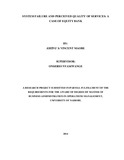| dc.description.abstract | The banking industry in Kenya in the recent past has experienced a lot of innovations and
changes in service delivery that have been prompted by competition among banks,
especially for more customers. This has seen banks continually seek ways to improve
their services. For them to succeed, each bank has to make sure their structures coordinate
properly to deliver the highest levels of service to their customers since there
exists a lot of competition in the industry. This study sought to investigate system failure
and perceived quality of services using a case study of Equity Bank. The study was
guided by two objectives: (i) To determine the customer‟s perception of the quality of
services offered by Equity Bank (ii) To determine the relationship between system failure
and perceived quality of services at Equity Bank. To meet the objectives, a quantitative
case study approach that targeted Equity Bank customers in a few selected Equity bank
branches in the NCBD was used. In total, 352 systematically sampled respondents
participated in the study. Responses from 288 respondents formed the basis of the
findings of this study. Questionnaires were used as the research instruments used to
collect data. Data gathered was analyzed quantitatively using correlation analysis and
presented in tables, bar graphs, and means and frequencies calculated to give meaningful
conclusions. The SERVQUAL model was used in the correlation analysis. The findings
of the study reveal that most of the customers at Equity bank consider the quality of
service delivery as good despite the bank performance not meeting customer
expectations. From the gap analysis there exist a gap between customer expectation and
perceived quality of service. System failure at Equity Bank was found to greatly slow the
speed of processing customer queries, transactions, documents and other enquiries. The
respondents noted that at times, management and staff failed to communicate uniformly
and clearly across branches and departments, hence availing incomplete information to
customers. Assurance and responsiveness dimensions of service quality have direct effect
to the customers‟ perception on the quality of services. From this study, there is need for
banks to ensure that they don‟t ignore customers‟ perceptions on the quality of service.
At the same time, banks should employ more ways of addressing empathy dimensions as
well as their responsiveness to customer needs so as to improve on customer perception
on quality of service | en_US |

